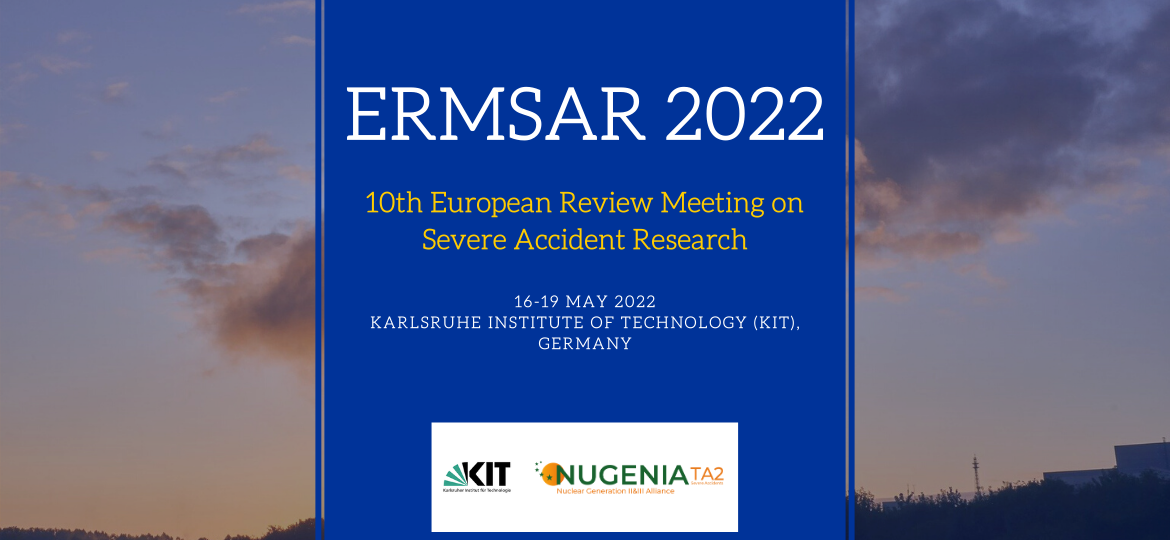
The 10th edition of ERMSAR (European Review Meeting on Severe Accident Research), in memory of Martin Kissane, was successfully held from 16 to 19 May 2022 in Karlsruhe, hosted by KIT. It gathered 118 participants (more than 100 in presence!) from nearly 50 organizations settled in 21 countries worldwide, which highlights ERMSAR as the reference international conference on Severe Accidents (SA). Sixty papers were orally presented and 9 more were exhibited as posters, among which two submitted by Ukrainian researchers. For the fourth time, ERMSAR has been organized in the frame of the Technical Area 2 of the NUclear GENeration II and III pillar (NUGENIA TA2) of the SNETP Association, and for the first time in collaboration with IAEA and OECD/NEA. This strengthens ERMSAR in many regards and in particular in terms of its international visibility. Such a collaboration is intended to be kept in future editions.
The conference focused on the latest progress of knowledge on Severe Accidents (SA) and has been an opportunity for researchers to be able discuss future R&D needs in this field in person. Some of these new needs will be addressed by three future Horizon Europe Projects, born inside NUGENIA TA2: SEAKNOT (for SA knowledge management, preservation, and efficient orientation towards most demanding needs), ASSAS (for the possible Artificial Intelligence use in SA simulations), and SASPAM-SA (for the application of current SA grounds to water-cooled SMRs). Furthermore, as highlighted from the ERMASR 2022 presentations, experimental/theoretical investigations in SA area are still on-going and/or planned in different international projects, including MUSA, to tackle open issues. New calculation models or new approaches are being developed and tested, with particular emphasis on those phenomena affected by large uncertainties and high potential influence on a SA unfolding and/or mitigation.
Several MUSA-related papers were presented:
- “Status of the Uncertainty Quantification for Severe Accident Sequences of Different NPP Designs in the Frame of the H-2020 Project MUSA“, Brumm (JRC)
- “Uncertainty Quantification for a Severe Accident Sequence in a SFP in the Frame of the H2020 Project MUSA: First Outcomes“, Coindreau (IRSN)
- “Uncertainty and Sensitivity Analysis of the ASTEC simulations results of a MBLOCA scenario at a Generic KONVOI Plant using FSTC tool“, Stakhanova (KIT)
- “CIEMAT’s outcomes from the PHEBUS-FPT1 uncertainty analysis in the framework of the EU-MUSA project“, Bocanegra (CIEMAT)
- “Parametric analysis of FPT-1 MELCOR 2.2 input deck as a preparation for uncertainty quantification study“, Malicki (PSI)
As major conclusions from ERMSAR 2022 it is also possible to highlight:
- A good part of R&D will continue investigating on SA mitigation, in particular on feasibility/development of “new” mitigation measures.
- An increased investigation is on the floor about very near-term deployment systems, like PW-SMRs, with a major take on “safety demonstration” and current analytical tools drawbacks for “very innovative” systems and the potential ways to overcome some of these limits. Additionally, it will be necessary to identify experimental data needs in pursuing the aim of studying non-LWR designs and, in the longer term, the V&V of codes for the licensing of such systems.
- Efforts should be also oriented to widen the range of applicability of the SA codes both to Gen-IV technologies and to further improve the modelling of specific components in deployed systems. It is also considered timely to soundly set of SA research needs and priority towards new technologies, e.g. SMRs, ATFs and find the best use possible in the area of AI/machine learning, with focus on safety-relevant phenomena (“risk informed”).
Next edition, ERMSAR2024, will be organized in the frame of the SEAKNOT project by KTH in Stockholm in May 2024.

